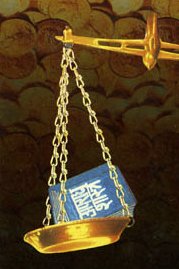Mahapradhana, Maha-pradhana, Mahāpradhāna: 4 definitions
Introduction:
Mahapradhana means something in Hinduism, Sanskrit, the history of ancient India. If you want to know the exact meaning, history, etymology or English translation of this term then check out the descriptions on this page. Add your comment or reference to a book if you want to contribute to this summary article.
In Hinduism
Arthashastra (politics and welfare)
Source: Shodhganga: Kakati Ganapatideva and his times (artha)Mahāprādhana (महाप्राधन, “chief minister”) is an official title designating one of the seventy-two officers (niyoga) of the Bāhattaraniyogādhipati circle, according to the Inscriptional glossary of Andhra Pradesh (Śāsana-śabdakośāmu). The bāhattaraniyoga-adhipati is the highest executive officer of this circle (including a Mahāpradhāna). For example: During the reign of Gaṇapatideva, the area extending between Pānagal to Mārjavāḍi was entrusted to Gaṇḍapeṇḍāru Gangayasāhiṇi as Bāhattaraniyogādhipati. Later on, this office was entrusted to Kāyastha Jannigadeva.
The Mahāprādhana was generally incharge of a province or a district. In addition to duties as mahāprādhana they were also holding other offices of sarvādhikāris and mahāmātvas and so on. Generally mahāprādhanas are associated with the sāmanta families more or less enjoying the same status. It seems that merit was taken into consideration rather than caste or community.

Arthashastra (अर्थशास्त्र, arthaśāstra) literature concerns itself with the teachings (shastra) of economic prosperity (artha) statecraft, politics and military tactics. The term arthashastra refers to both the name of these scientific teachings, as well as the name of a Sanskrit work included in such literature. This book was written (3rd century BCE) by by Kautilya, who flourished in the 4th century BCE.
India history and geography
Source: What is India: Inscriptions of the ŚilāhārasMahāpradhāna (chief minister) was a title used in the administration during the rule of the Śilāhāra dynasty (r. 765-1215 A.D.).—The mahāpradhāna was called sarvādhikārī in one record. The king appointed Counsellors (mantrins) and Ministers (mahāmātyas), for example, the mahāpradhāna, for the various departments. Their names together with their official designations occur in several records of the Northern Śilāhāras and prove useful in chronological discussions. In North Koṅkaṇ the ministers were generally five in number.
The mahā-pradhāna and the mahā-sāndhivigrahika were more important than the others; for they are invariably mentioned in almost all records of the Northern Śilāhāras.
Source: Cologne Digital Sanskrit Dictionaries: Indian Epigraphical GlossaryMahāpradhāna.—(IE 8-3; EI 30; CII 4; BL; HD), ‘the great minister’; ‘the chief minister or administrator’; sometimes also called Mahāsāmanta-adhipati, Antaḥpura-vĕrgaḍĕ (ºādhyakṣa), Mahāpasāyita, Senāpati, Hĕri (Mahā) sandhivigrahika, Manĕ- vĕrgaḍĕ, Kaḍitavĕrgaḍĕ, Senādhipati, Antaḥpura-adhyakṣa, Hĕri-Lāḻa- Kannaḍa-sandhivigrahin, Bhānasa-vĕrgaḍĕ, Accupanāyadadhiṣṭhāyaka, Sarvādhikārin, Hĕri (Mahā) bhāṇḍāgārin, Bāhattaraniyogādhipati, Paṭṭasāhaṇa-adhiṣṭhāyaka, Senāpati, Daṇḍanāyaka, Mahāsāmanta, Senādibhāhattaraniyoga-adhiṣṭhāyaka, Mahāmātya, Paramaviśvāsin, Mahāparamaviśvāsin, etc., additionally. Cf. Ep. Ind., Vol. V, p. 28. (SITI), senior councillor of the king, usually a military officer; same as Mahāpradhāni. See Pradhāna. Note: mahāpradhāna is defined in the “Indian epigraphical glossary” as it can be found on ancient inscriptions commonly written in Sanskrit, Prakrit or Dravidian languages.

The history of India traces the identification of countries, villages, towns and other regions of India, as well as mythology, zoology, royal dynasties, rulers, tribes, local festivities and traditions and regional languages. Ancient India enjoyed religious freedom and encourages the path of Dharma, a concept common to Buddhism, Hinduism, and Jainism.
Languages of India and abroad
Kannada-English dictionary
Source: Alar: Kannada-English corpusMahāpradhāna (ಮಹಾಪ್ರಧಾನ):—[noun] the principal minister and advisor of a king.
Kannada is a Dravidian language (as opposed to the Indo-European language family) mainly spoken in the southwestern region of India.
See also (Relevant definitions)
Partial matches: Maha, Pradhana.
Starts with: Mahapradhana-nayaka.
Query error!
Full-text (+35): Mahapradhana-nayaka, Mahamatya, Senadhipati, Mahapradhani, Mahamantri, Mahamatra, Sarvadhikari, Mahapĕriyapradhana, Ahavamalladeva, Lakshmanaprabhu, Padalu, Mahabhandagarin, Accupannayadadhishthayaka, Bhabhana-shreshthin, Durga-shreshthin, Dhanama-shreshthin, Preggada, Mahaparamavishvasin, Parama-vishvasin, Kadita-vĕrgadĕ.
Relevant text
Search found 6 books and stories containing Mahapradhana, Maha-pradhana, Mahā-pradhāna, Mahāpradhāna; (plurals include: Mahapradhanas, pradhanas, pradhānas, Mahāpradhānas). You can also click to the full overview containing English textual excerpts. Below are direct links for the most relevant articles:
Later Chola Temples (by S. R. Balasubrahmanyam)
Temples in Pulivay < [Chapter XIV - Temples of Rajaraja III’s Time]
Studies in Indian Literary History (by P. K. God)
10. The Genealogy of Mandana < [Volume 1 (1945)]
23. Chronology of a Nagara Brahmin Family of Physicians in Gujarat < [Volume 2 (1954)]
World Journal of Pharmaceutical Research
Fractionalised approach of pathya-apathya in medovahasrotho dushti vikara < [2022: Volume 11, November issue 15]
The history of Andhra country (1000 AD - 1500 AD) (by Yashoda Devi)
Part 2 - Choda I (A.D. 1109—1136—37) < [Chapter I - The Velanandu Chodas of Tsandavole (A.D. 1020-1286)]
Glories of India (Culture and Civilization) (by Prasanna Kumar Acharya)
Civil administration (in ancient India) < [Chapter 3 - Political life of State sovereignty and Individual liberty]
Kannada Versions of the Puranas < [Purana, Volume 6, Part 1 (1964)]